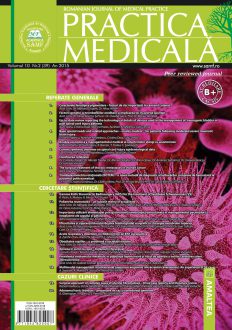SELECT ISSUE

Indexed

| |

|
|
|
| |
|
|
|

|
|
|
|
|
|
|
HIGHLIGHTS
National Awards “Science and Research”
NEW! RJMP has announced the annually National Award for "Science and Research" for the best scientific articles published throughout the year in the official journal.
Read the Recommendations for the Conduct, Reporting, Editing, and Publication of Scholarly work in Medical Journals.
The published medical research literature is a global public good. Medical journal editors have a social responsibility to promote global health by publishing, whenever possible, research that furthers health worldwide.
Current synthetic overview on spinal cord injury (SCI) epidemiological data
Ioana ANDONE, Aurelian ANGHELESCU, Cristina DAIA and Gelu ONOSE
ABSTRACT
Aim. To have updated information on the epidemiology of spinal cord injury (SCI) is required for developing an adequate and effective related health policy strategies and consequent contextual decisions making regarding this category of patients and also for planning and implementing SCI prevention education and measures. Accordingly, the rationale of this article is to provide a systematic overview of the literature regarding SCI epidemiology.
Material and methods. We reviewed epidemiological published reports and searched on internet specifically databases, from different centres, worldwide, about SCI, collecting descriptive data for properly estimating the incidence, prevalence, and/ or causes of SCI.
Results. The global annual incidence rate is considered to be 23 cases of Traumatic Spinal Cord Injury (TSCI) per million (179,312 new cases per annum – results provided by World Health Organisation’s (WHO) in 2007). Prevalence per million inhabitants varies quite largely among statistics in different countries (from 280 in Finland to 681 in Australia, 755 in the United States of America or maybe even more, and even bigger in Canada). Men more commonly suffer from this kind of pathology and the direction of SCI evolution is to have a higher cord lesion level (more tetraplegics than paraplegics) and age at injury.
Conclusion. Even if the results of this literature review showed that the SCI incidence and prevalence are rising, they did not suffer significant changes in the last three decades of time. The prevalence surveys remain poor, mainly because a basic requirement for having correct and appropriately updated figures would need national and or regional electronic dedicated registers of evidence, and this is not a situation frequent enough. But the incidence studies from USA and Europe have been increased in the last years. This article asserts the need for improving the SCI data standardised collection in many countries, especially in the ones from low developed/ emergent areas.
Keywords: spinal cord injury, incidence, prevalence, epidemiology
